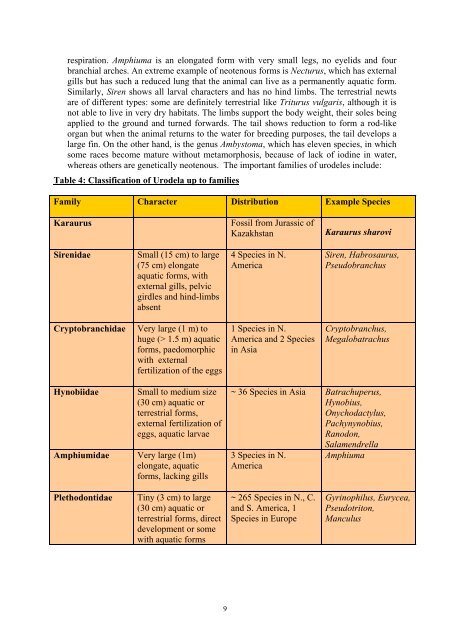Animal Diversity: Chordata
Animal Diversity: Chordata
Animal Diversity: Chordata
Create successful ePaper yourself
Turn your PDF publications into a flip-book with our unique Google optimized e-Paper software.
espiration. Amphiuma is an elongated form with very small legs, no eyelids and four<br />
branchial arches. An extreme example of neotenous forms is Necturus, which has external<br />
gills but has such a reduced lung that the animal can live as a permanently aquatic form.<br />
Similarly, Siren shows all larval characters and has no hind limbs. The terrestrial newts<br />
are of different types: some are definitely terrestrial like Triturus vulgaris, although it is<br />
not able to live in very dry habitats. The limbs support the body weight, their soles being<br />
applied to the ground and turned forwards. The tail shows reduction to form a rod-like<br />
organ but when the animal returns to the water for breeding purposes, the tail develops a<br />
large fin. On the other hand, is the genus Ambystoma, which has eleven species, in which<br />
some races become mature without metamorphosis, because of lack of iodine in water,<br />
whereas others are genetically neotenous. The important families of urodeles include:<br />
Table 4: Classification of Urodela up to families<br />
Family Character<br />
Distribution Example Species<br />
Karaurus Fossil from Jurassic of<br />
Kazakhstan<br />
Sirenidae Small (15 cm) to large<br />
(75 cm) elongate<br />
aquatic forms, with<br />
external gills, pelvic<br />
girdles and hind-limbs<br />
absent<br />
Cryptobranchidae Very large (1 m) to<br />
huge (> 1.5 m) aquatic<br />
forms, paedomorphic<br />
with external<br />
fertilization of the eggs<br />
Hynobiidae Small to medium size<br />
(30 cm) aquatic or<br />
terrestrial forms,<br />
external fertilization of<br />
eggs, aquatic larvae<br />
Amphiumidae Very large (1m)<br />
elongate, aquatic<br />
forms, lacking gills<br />
Plethodontidae Tiny (3 cm) to large<br />
(30 cm) aquatic or<br />
terrestrial forms, direct<br />
development or some<br />
with aquatic forms<br />
9<br />
4 Species in N.<br />
America<br />
1 Species in N.<br />
America and 2 Species<br />
in Asia<br />
Karaurus sharovi<br />
Siren, Habrosaurus,<br />
Pseudobranchus<br />
Cryptobranchus,<br />
Megalobatrachus<br />
~ 36 Species in Asia Batrachuperus,<br />
Hynobius,<br />
Onychodactylus,<br />
Pachynynobius,<br />
Ranodon,<br />
3 Species in N.<br />
America<br />
~ 265 Species in N., C.<br />
and S. America, 1<br />
Species in Europe<br />
Salamendrella<br />
Amphiuma<br />
Gyrinophilus, Eurycea,<br />
Pseudotriton,<br />
Manculus

















